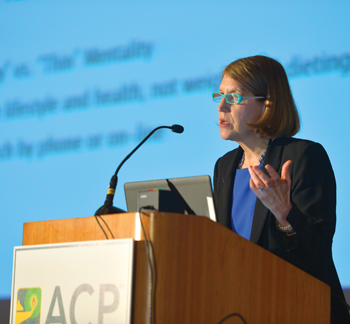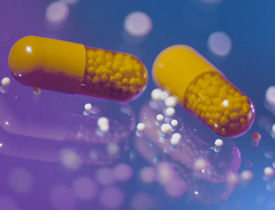Tips for using statins, PCSK9 inhibitors in chronic CAD
Guidelines for reducing cardiovascular risk are shifting with the evidence.
Call it a cholesterol changeup, but guidelines for reducing cardiovascular risk are shifting with the evidence.
Several health organizations suggest lowering LDL cholesterol to 70 mg/dL, but 2013 guidelines from the American Heart Association and the American College of Cardiology (AHA/ACC) shy away from specific targets, instead calling for a 50% reduction in LDL cholesterol.
These recommendations, however, are poised to change in the new AHA/ACC guidelines, which are expected to be published in the fourth quarter of 2018, said Stephen L. Kopecky, MD, a professor of medicine in the department of cardiovascular diseases at Mayo Clinic in Rochester, Minn.

A recent study of the new class of PCSK9 inhibitors suggested that 70 mg/dL may be too high of a threshold, since all outcomes improved after dropping LDL from 70 to 50 mg/dL, he noted. “The head of the guidelines is a numbers guy, and I think we'll go back to 70 [mg/dL], if not 50 [mg/dL], within the next 18 months,” he said.
But how low is too low? “You probably need an LDL of 25 [mg/dL] to do all your normal functions, but above 25 [mg/dL] is fine,” said Dr. Kopecky.
He provided tips on lowering cholesterol using statins and PCSK9 inhibitors in patients with chronic coronary artery disease (CAD) during the cardiology precourse at Internal Medicine Meeting 2017 in San Diego.
Statins
Despite the effectiveness of medical therapy to lower cholesterol, it's important to emphasize a lifestyle that does not counter what medicines might accomplish, Dr. Kopecky said.
For instance, a 2012 study in Circulation showed that patients on statins who adhered to the healthiest diet compared to the unhealthiest diet reduced their risk of cardiovascular death, myocardial infarction, stroke, or congestive heart failure by 24%, Dr. Kopecky said. “But 40% of patients in this 20,000-patient study did not benefit,” he said. “So the point is, if you're not eating healthy, the benefits of a statin are greatly reduced.”
The same concept applies to physical fitness. “I tell patients that being physically fit enhances the benefit of the statin, and the statin does not replace lifestyle,” Dr. Kopecky said.
As if getting patients to adhere to healthy lifestyle changes weren't challenging enough, statin intolerance remains a challenge for patients who report myalgia with statin therapy. “There's no gold standard for [diagnosing] statin intolerance—that's the problem,” said Dr. Kopecky, who runs a statin intolerance clinic. In recent trials, he said, about 75% of patients are able to tolerate some statin therapy.
If a patient may be intolerant to statins, he recommends stopping the drug for a month before starting a different statin. If the patient is intolerant to three or more statins, she may be able to tolerate a less-than-daily dose, Dr. Kopecky said. For instance, twice-weekly rosuvastatin (5 mg), available in generic form as of 2016, “can get a 25% reduction in their LDL, and most people can tolerate once or twice a week,” he said.
Also, he described why two ethnic groups deserve special consideration when prescribing statins.
About 8% of African-American men have a baseline creatine kinase level that is more than three times the upper limit of normal, so be sure to check that value before prescribing a statin, Dr. Kopecky suggested. And Asians, especially Southeast Asians, achieve greater LDL reduction with statins than Westerners, he said. “It's not in the guidelines, but I start about a quarter of a dose of the normal recommended dose in Asians because they respond very well and … have a 10 times higher incidence of myopathies. So just start low, and you can always work up later,” he said.
PCSK9 inhibitors
PCSK9 inhibitors, which were approved in 2015, should be reserved for specific patients because they're so expensive, Dr. Kopecky said. “The ideal patient for this therapy has three qualities: familial hypercholesterolemia, statin intolerance/not at goal, and atherosclerotic cardiovascular disease,” he said. “Many of these patients have been on every statin in the book.”
Internists should think of familial hypercholesterolemia when LDL is greater than 190 mg/dL and when the patient has early CAD (before age 65 in women and age 55 in men) or a family history of early CAD, said Dr. Kopecky. About 1 in 200 people in the U.S. have familial hypercholesterolemia and have a 50% chance of passing the disease to their children, he said.
Clinical clues are also apparent in patients with familial hypercholesterolemia, which can present as xanthelasma on the inner corner of the eye or xanthoma on the hand (which are both apparent in da Vinci's “Mona Lisa,” Dr. Kopecky demonstrated). “Always look for tuberosities: Ask people if they've ever had xanthelasmas, or if Uncle Frank did or Grandma did,” he said. “They go away when they start a statin, but it's helpful to note they had them.”
PCSK9 inhibitors are very effective in treating familial hypercholesterolemia and work better than statins alone, but they should not be used to replace statins, Dr. Kopecky said. “Make sure that every one of these patients is on a statin—even once a week, whatever they can take—because a statin will raise their LDL receptors, which is where the PCSK9 works,” he said.





